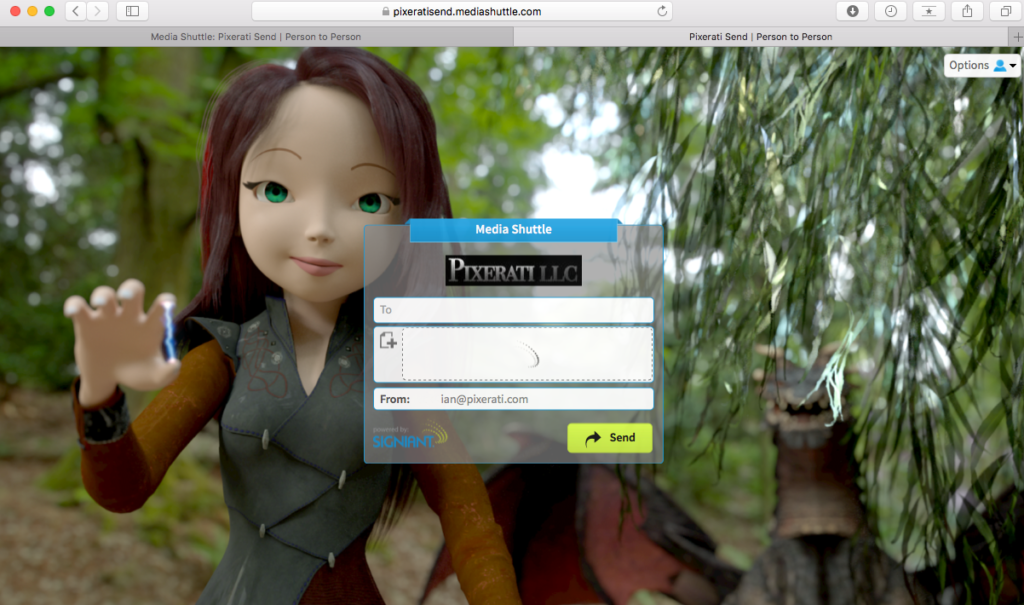Easy, Fast and Secure Media File Transfer – the Bigfoot of Post
Signiant’s Media Shuttle service may just make believers out of postproduction-hardened cynics.
By Damian Allen
I have a long list of “It’s 2017, how come we haven’t figured out how to…” questions. Topping that list (alongside why Siri still can’t look up a phone number for me without mistakenly calling someone to whom I owe money instead) is the issue of transferring video files securely across the web. There typically seems to be a choice: send files easily or send them securely. The easy way is an email attachment if it’s small enough, wetransfer.com if it’s a little bigger, or a thunderbolt drive couriered across town if it’s colossal. The secure way is an expensive, industrial service that typically requires the installation of software on your client’s machine whether they like it or not. So taking all that into account I was curious to try out Signiant’s offering, Media Shuttle. This is a service specifically geared toward ease-of-use and is perfect for small to mid-sized companies (i.e. boutique post houses). It promises the simplicity that busy people demand without compromising security. Let’s take a look.
You can hold my hand, but don’t waste my time
I’m not a big fan of user guides or guided tours. I’ll waste a couple of hours trying to figure things out by myself before asking for help. (In other words, I’m a typical male.)
Having said that, I was pleasantly surprised by the screenshare introduction to Media Shuttle. Maybe I got lucky with the session being hosted by Signiant’s Tyler Cummings, but within about 20 minutes of my time (thirty counting my obnoxious questions) Tyler had pretty much shown me the entire system from start to finish.
So what exactly is Media Shuttle and how does it work? There are three main ways to move files across the internet using Media Shuttle: “Send”, “Share”, and “Submit” (the first two are for sending, the latter is for receiving to your server).
The Send Portal
The Send Portal option is a very simple email web page–think wetransfer.com. Type in a recipient’s email address, drag the files you want to send to the browser, and click send.
Now when I make the comparison to wetransfer.com it’s a pretty shallow one; there’s a whole lot more going on here than your standard WeTransfer session.
First of all, there’s no file size limit. That’s a bigger deal than it seems at first. Even with open source, self-hosted systems like ownCloud large transfers frequently fail to deliver successfully.
Secondly, you can send entire folders and subfolders without zipping them first. This is huge if–like me–you’re constantly dealing with massive EXR and DPX image sequences. A multi-layered EXR can easily weigh in at over 100MB per frame; trying to zip those suckers up first (if you actually succeed) can take longer than sending the actual files.
Media Shuttle actually uses its own proprietary transfer protocol optimized for large file sizes rather than the office documents that generic transfer services are designed for. We’ll talk a little more on that later, but in essence it means that your transfer speeds won’t suffer from being uncompressed. (In fact, media files rarely benefit from being zipped–they’re already compressed at the file level.)
Next, you can send with whatever level of security required. Is the content extremely sensitive? You can require that the recipient logs in securely to the Media Shuttle portal before downloading the files. For additional protection, you can require a user-generated password for download. Or do you have a technology-challenged client that wants a straight download without the hassle? Assuming the content isn’t too sensitive, you can make set up for the download to be a single click from the email.
Another nice touch is the ability to customize the look of each portal page. This can make your one or two man shop feel a lot bigger and slicker than it really is. (After all, the client never needs to know that you finished the conceptual art for their campaign in your bathroom on a laptop.) Unique pages can be created for different clients or projects, at no additional cost.
The Share Portal
Now I’ve worked on small campaigns and big Hollywood blockbusters, and I’m amazed at how often proprietary information just gets thrown on an unsecured FTP server for me to download. This is especially true in the last two weeks before picture lock on a movie; studio execs with little tech savvy will find the path of least resistance when they need to get files to a post house during crisis hour. Security goes out the window and production staff find FTP servers an easy way to give vendors instant access to a set of files.
Media Shuttle offers a no-nonsense “FTP-like” interface to entire folder structures, so a client can browse and choose the files and folders they want to download. But it’s not FTP–it uses 256-bit AES encryption system, the security scheme recommended by the MPAA.
Security is, of course, paramount, and FTP is an inherently insecure way to share files. SFTP is better, but typically frustrates non-savvy users who have to configure an FTP client to the correct protocol.
As the host of the files, you’re completely in control of which folders a given client can have access to. Permissions are easily configured from the portal management page. On numerous occasions I’ve been frustrated trying to set permissions on SFTP servers only to end up either locking out the client or showing them too much. The Media Shuttle configuration is blissfully simple in comparison.
The Submit Portal
A third transfer option pushes files to your storage. This is basically a drop box that allows a client to send you a file (and add an optional message). Again the emphasis here is on simplicity: drag files or folders to the browser and you’re done. To benefit from Signiant’s advanced transfer over UDP, the Signiant app needs to be installed (it’ll be automatically triggered by the browser page).
The only thing I would have liked here is an option to automatically generate a timestamped folder name for incoming files (e.g. incoming_05_31_17_1500) to help keep versioning straight under deadlines, but again this starts to add custom complexity. That kind of thing can always be handled via a local watch script sitting on the server anyway.
Simplicity beats complex efficiency
I feel the need to digress for a moment on this point. I can’t emphasize enough how simplicity trumps level of customization. The obvious example in the world is Mac vs. PC. But I’ve seen it time and again in the post-production world. Complex systems break down in crisis. And production staff are great organizers but not always the best technologists. They’re also way too busy to spend a day in a seminar learning how to use a proprietary digital asset management system.
So even though Media Shuttle emphasizes simplicity, it no doubt fits well with the larger studios. I remember when we first implemented Shotgun at my studio: for the first three months I had a PA translate the reports and enter data for me because I simply didn’t have the downtime to learn how to use the interface. Media Shuttle does its job and hides the complexity. No need to write a thousand lines of python scripting just to get files moving.
As a quick note: APIs do exist for larger studios looking to implement Media Shuttle with their DAMs and MAMs; they’re just not necessary for taking advantage of Media Shuttle’s file transfer services.
Managing the system
Configuring a file transfer service is typically a nightmare for those of us who don’t spend our lives grepping, piping, and rebooting Apache services on Linux servers. What surprised me as I went to work on Media Shuttle is the fact that I didn’t need to pull up a single help doc or call for tech support. Let me give you an example workflow:
To add a client to the Share Portal (the “FTP-like” web page) I choose “Person to/from File System” from the choice of portals at the top of the management page.
Then I select the members tab and click Add. I type in their name, email address and the expiration date–the date I want their access to the site to cease. By default they have access to the entire server. But if I simply click the Change button, I can choose a specific directory level of limited access. Finally I check the boxes for upload access, download access, and edit access and I’m done. The client is now able to access the relevant files and only the relevant files.
There is a help section at top right of the page that explains options in plain English. At no point did I feel like I needed to be a Microsoft Certified Systems Engineer to manage the system. I’ve had a harder time configuring my home wifi router.
You can create as many of these portals as you like to help partition work between clients, or tasks (e.g. VFX vs editorial). So the system can be extremely flexible, even while keeping the complexity to a minimum.
Hosting
Just to be clear about one point: Media Shuttle is a transfer service, not a hosting service. They don’t own the storage your stuff sits on. Who does? Well, you do probably. Media Shuttle works either as an application sitting on top of your existing Linux or Windows file server, or in partnership with a cloud-based hosting service.
The only bummer here is lack of OS X server support. While many studios have switched to some kind of Linux file server, there are plenty of small creative boutiques still serving their files from a Mac Mini, so that’s something to consider when switching to Media Shuttle. When I mentioned this to Signiant they recommended using a virtual machine like Parallels on the host server. Seems like that would work just fine; data transfer to/from the outside world would be a bottleneck long before the overhead of the VM became an issue.
As far as configuration goes, Tyler from Signiant assured me that the install was painless and that if any complications arise Signiant’s tech support can walk you through configuration in a matter of minutes.
For my evaluation I took advantage of the cloud-based hosting option. Media Shuttle is ready to work out of the box with either Amazon’s S3 offering or Microsoft Azure. In the case of cloud hosting, Signiant attaches to either of the services. The process and offering is the same, albeit with the addition of a monthly payload allotment to account for cloud service transfer fees. I can’t speak to the locally hosted experience (although I have a feeling I’ll be implementing it sometime over the coming year), but the cloud-based service behaved flawlessly.
Security and transfer rates
I am not an internet security expert, nor a dark web hacker, so I can only take Signiant’s word as to the security of their system. However, having previously endured the process of MPAA certification at my own studio and having been involved in security audits while working on the lot at one of the majors, I can attest that Signiant’s transfer process being in line with MPAA recommendations is no small thing.
As far as transfer rates, in my very informal testing I found them to be “alarmingly fast.” How fast is that? Well, 2.1 GB of EXR files took 52 seconds to download from the Amazon host server. 20 seconds of that time was file prep and handshake (which I imagine would be pretty consistent even on larger pulls), so that puts the actual transfer speed at around 525 Mbps. Now my connection on speedtest.net measures at around 370 Mbps. How can Media Shuttle be that much faster? I have to assume it’s because speedtest.net is measuring based on highly-redundant TCP packets, while Media Shuttle is leveraging its proprietary protocol sitting on top of UDP. Whatever the case, it’s fast. (In a very unscientific comparison test, 150MB of EXRs took less than 10 seconds to upload–including the handshake period at the front end, while the same files took over 3 minutes to send via the free wetransfer.com service.)
What’ll it cost me?
When enterprise-style solutions are discussed in the post-production world, most people assume that “if you have to ask the price, you can’t afford it.” As we’ve mentioned though, Media Shuttle is perfect for boutique studios, so the price obviously needs to work for that market segment. The “professional” packages begin at $7,500 a year but there’s special pricing for companies with fewer than 20 employees. Everything is based on the number of active users per month; there’s no limit to how much data you’re permitted to transfer. The Signiant definition of an “active user” is someone who sends a file or receives three or more files in a given month. These are floating user licenses, so you can have as many users as you like in the system (e.g. multiple clients) and in a given month only those users that meet this definition of “active” will be counted against your quota.
If you’re just getting started and running a lean ship, that might seem a little steep. But one thing that was clear to me from my conversations with Signiant: their pricing structure isn’t set in stone. Signiant is eager to make the service work for smaller companies (under 20 employees) and will endeavor to design a package around the needs of the client.
Overall, I’ve been impressed by the flexibility and transparency of the pricing structure. Want to create separate portals to the physical storage at your studio and a different setup at your house? No extra charge. Have media storage pools distributed between offices in New York, Los Angeles, and Sydney? Create a unique portal for each. What about local storage for team collaboration and an Amazon S3-based portal for clients? Again, no additional hidden fees.
Of course if you’re trying to court bigger clients, even the $7,500 annual base could end up being a trivial cost in comparison to the payoff. Larger client businesses will instantly balk at unprofessional work practices and media transfer is one of the first encounters a new client will have with you in this connected world.
Conclusion
As you’ve probably already guessed, I was impressed with the Media Shuttle ecosystem. It’s rare that I come across enterprise level software that has as much intuitive usability. With the caveat that I’m yet to test the system on my locally-hosted file server, I’ve found little not to like with the service.
Boutiques already well established will instantly see the value proposition here. The alternative is to run your own file services. This might seem like a good (cheaper) approach out of the gate, but once you add configuration, IT costs, lack of security, and the sheer amount of time spent trying to manage permissions and maintain everything, $7,500 a year can be a downright bargain.
Visit Signiant’s Media Shuttle site for more information.





